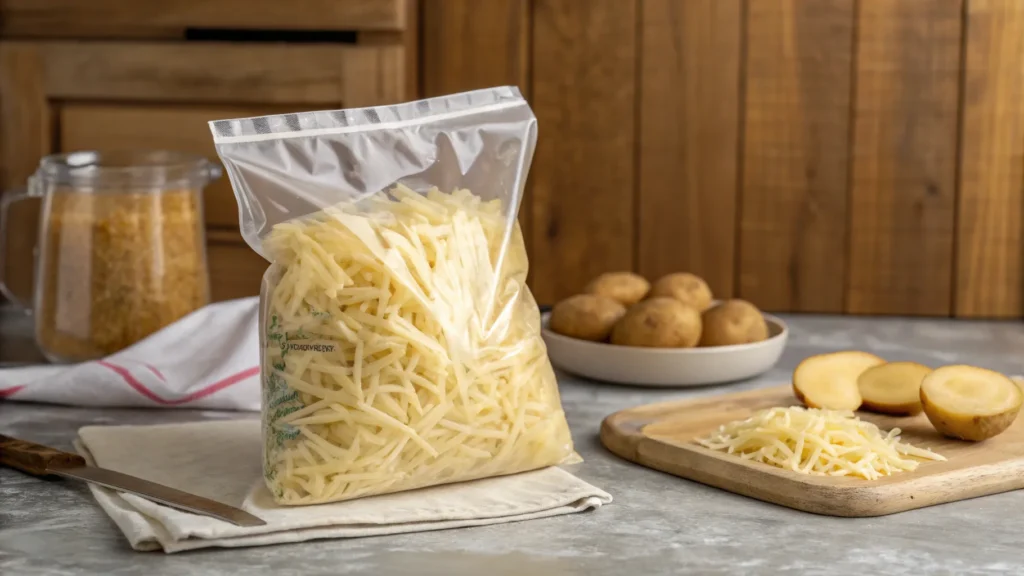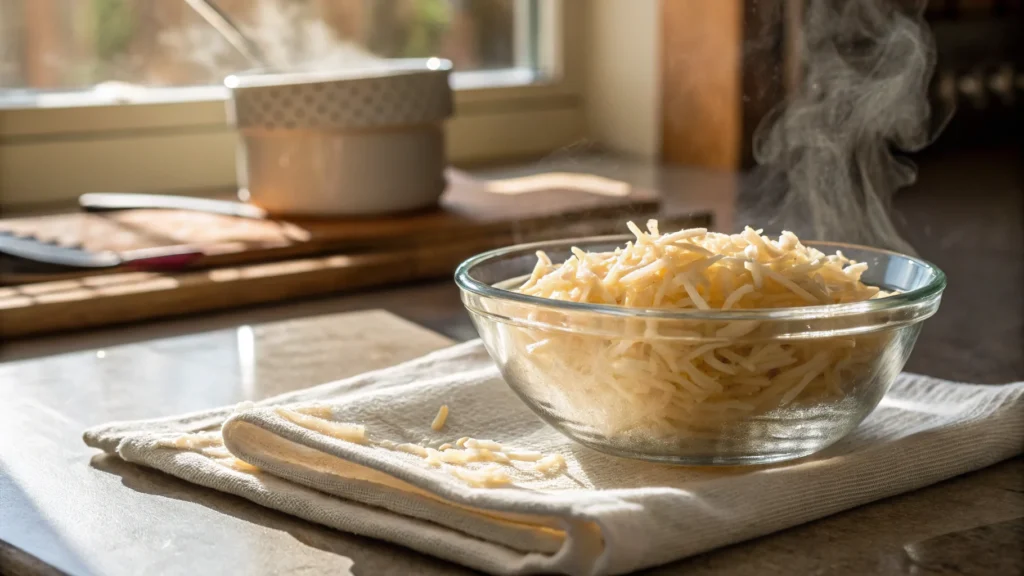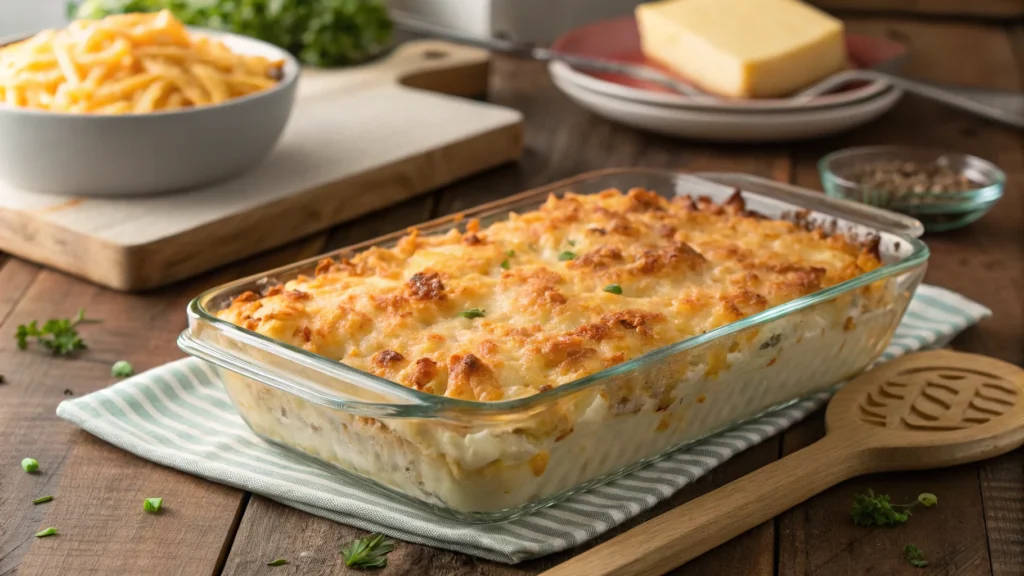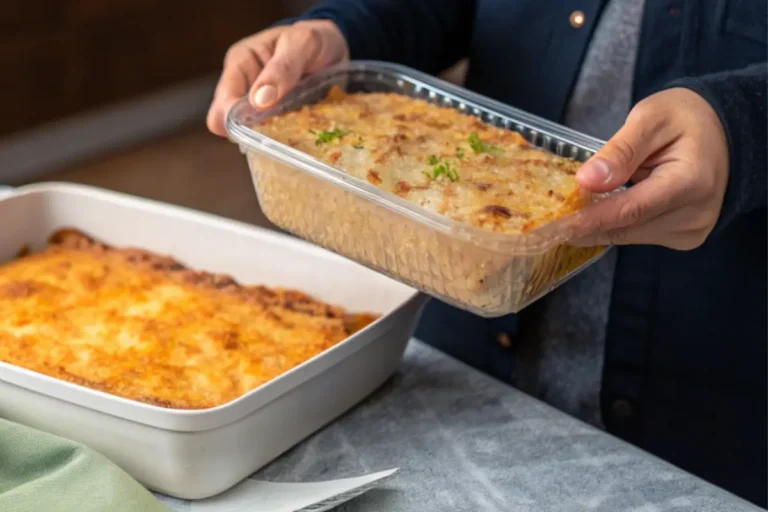When preparing a delicious casserole, one question often arises: “Do I have to thaw frozen hash browns for casserole?” This seemingly simple query has sparked debate among cooks and home chefs alike. Understanding whether or not to thaw hash browns before adding them to your dish can significantly impact your recipe’s texture, flavor, and overall success. In this guide, we’ll Discover everything you need to know about frozen hash browns and their role in casseroles, ensuring your dish turns out perfectly every time.
Table of Contents
What Are Frozen Hash Browns?
Frozen hash browns are a kitchen staple, offering convenience with their pre-shredded or diced potatoes that are partially cooked before being frozen. These pre-prepared potatoes save time and effort, especially when making casseroles. But do I have to thaw frozen hash browns for casserole? The answer depends on several factors, including the recipe and cooking method. To learn more about creating outstanding dishes with hash browns, check out How to Make the Perfect Hashbrown Casserole.
- Pre-cooked Convenience: Frozen hash browns are blanched before freezing, preserving their color and flavor.
- Variety of Cuts: They come in shredded, diced, or patties, offering versatility in recipes.
- Ease of Use: Their frozen state makes them perfect for quick meals, but their texture may differ when used directly.
Understanding the composition and purpose of frozen hash browns sets the stage for determining whether thawing is necessary. Additionally, their pre-cooked nature makes them versatile, saving valuable time when you’re in a hurry.

Why Thaw Frozen Hash Browns?
The question “Do I have to thaw frozen hash browns for casserole?” hinges on the advantages of thawing. Allowing frozen hash browns to defrost can Improve their performance in a recipe by improving texture and ensuring even cooking.
- Even Heat Distribution: Thawed hash browns cook evenly, preventing cold spots in your casserole.
- Reduced Moisture: Frozen potatoes release water as they cook, making casseroles soggy if not drained beforehand.
- Improved Flavor Absorption: Thawed hash browns soak up seasonings and other ingredients better than frozen ones.
- Improved Binding: Thawed hash browns bind better with other ingredients in some recipes, creating a cohesive dish.
When planning your next culinary creation, consider how thawing can Improve your recipe’s outcome. For unique recipe inspirations, such as pairing hash browns with unconventional toppings, Discover Pickle Pie Pizza Ideas for Special Occasions.
When Should You Thaw Hash Browns?
The answer to “Do I have to thaw frozen hash browns for casserole?” depends on your recipe’s requirements. Specific scenarios call for thawing, while others allow you to use hash browns straight from the freezer.
Instances When Thawing Is Essential:
- Layered Casseroles: Thawed hash browns. Confirm even cooking in multi-layered dishes.
- Short Bake Times: Recipes with quick cooking durations require thawed ingredients to avoid raw centers.
- Moisture-Sensitive Dishes: Casseroles prone to excess liquid benefit from defrosted hash browns.
- Recipes with Delicate Ingredients: Thawed hash browns prevent longer cooking times that could overcook other dish elements.
When You Can Skip Thawing:
- High Heat Recipes: Intense oven temperatures can handle frozen hash browns effectively.
- One-Pot Dishes: If other ingredients require prolonged cooking, frozen hash browns might work.
- Personal Preference: Some cooks prefer the unique texture of partially cooked hash browns in their casseroles.
- Time Constraints: If you’re in a rush, skipping the thawing step can yield satisfactory results with proper adjustments.
How to Thaw Frozen Hash Browns
If you’ve determined that thawing is necessary, the next step is understanding how to defrost them effectively. “Do I have to thaw frozen hash browns for casserole?” is only part of the process—knowing the proper methods to thaw is equally crucial.
Recommended Methods:
- Refrigerator Thawing: Place the hash browns in a bowl, cover them, and let them defrost overnight. This method is the safest and preserves texture.
- Microwave Thawing: Set your microwave to the defrost function to speed up the process. Once thawed, carefully drain any excess liquid to prevent sogginess or uneven texture.
- Room Temperature: Spread the hash browns on a baking sheet and let them sit at room temperature for 30 minutes to an hour.
- Cold Water Bath: Seal the hash browns in a plastic bag and submerge them in cold water for faster thawing.

Tips for Best Results:
- Pat Dry: Press thawed hash browns with paper towels to absorb any remaining moisture.
- Avoid Over-Thawing: Over-defrosting can make the potatoes mushy and difficult to work with.
- Season Early: Thawed hash browns absorb flavors better, so season them before incorporating them into your casserole.
These methods provide flexibility, ensuring your hash browns are perfectly thawed and ready for use, no matter the time available.
Risks of Not Thawing Hash Browns
Ignoring the question, “Do I have to thaw frozen hash browns for casserole?” can lead to potential risks. While it may seem convenient to skip the thawing step, it could compromise your dish’s texture, flavor, and cooking time.
- Uneven Cooking: Frozen hash browns may remain cold in the center while the rest of the casserole cooks.
- Excess Water: As frozen hash browns heat up, they release moisture, which can result in a watery casserole.
- Texture Issues: Using frozen potatoes directly can produce a chewy or rubbery texture.
- Inconsistent Flavor: Frozen hash browns might not absorb seasonings as effectively as thawed ones.
Mitigating Risks:
- Increase Cooking Time: Allow extra minutes for the casserole to Confirm thorough cooking.
- Use a Baking Sheet: Pre-baking frozen hash browns can help remove excess moisture.
- Monitor Consistency: Stirring halfway through cooking can help distribute heat evenly.
- Adjust Ingredients: Reduce liquids in the recipe to counterbalance moisture from frozen hash browns.
Can You Use Frozen Hash Browns Without Thawing?
When preparing this beloved comfort dish, the question, “Do I have to thaw frozen hash browns for casserole?” often arises. While it’s possible to use frozen hash browns directly in your casserole, skipping the thawing process may lead to uneven cooking. The frozen texture can release excess moisture during baking, potentially making the casserole watery or less flavorful. This can be especially problematic if your recipe includes creamy or cheese-based components that rely on the right consistency.
However, frozen hash browns can work well without thawing, particularly in recipes that account for the extra moisture or require longer cooking times. To balance convenience and quality, some recipes suggest partially thawing the hash browns. This approach allows for more even cooking while saving some prep time. Regardless of your choice, following the recipe’s instructions carefully is crucial.
Tips for Perfectly Thawed Hash Browns
Mastering the art of thawing hash browns confirms that your casseroles turn out just right. If you’ve wondered, “Do I have to thaw frozen hash browns for casserole?” the answer is understanding how to thaw them effectively. Here are a few methods:
- Refrigerator Thawing: Place the hash browns in a covered container or sealable bag and let them thaw in the fridge overnight. This method preserves their texture and minimizes moisture loss.
- Microwave Thawing: For quicker results, use a microwave-safe dish. Heat the hash browns on a low setting for 1-2 minutes, checking frequently to avoid partial cooking.
- Thawing at Room Temperature: Arrange the hash browns in a single, even layer on a baking sheet lined with absorbent paper towels. Let them rest at room temperature for about 30 to 60 minutes. This method ensures they defrost evenly while the paper towels gently absorb any excess moisture, preserving their texture.
After thawing, pat the hash browns dry with paper towels to remove excess moisture. This step is essential for preserving your casserole’s ideal texture and consistency, ensuring every bite is perfectly balanced and delicious.
To learn how to perfect your hash brown dishes and avoid these pitfalls, visit How to Make the Perfect Hashbrown Casserole.
Popular Recipes Using Frozen Hash Browns
The versatility of hash browns makes them a favorite ingredient in various recipes. If you ask, “Do I have to thaw frozen hash browns for casserole?” you’ll find that many dishes benefit from thawing. Here are some popular recipes:
- Classic Hash Brown Casserole: Mix tender hash browns with rich sour cream, savory cream of chicken soup, and gooey shredded cheese. Top it off with a crunchy, golden layer for a comforting dish that will delight any crowd.
- Breakfast Casserole: Combine perfectly thawed hash browns with fluffy eggs, savory sausage, and melted cheese to create a hearty and satisfying morning dish that everyone will love.
- Cheesy Potato Bake: Layer hash browns with cheese and seasonings for a simple yet flavorful side dish.
Each recipe may require a different approach to thawing, so always follow the specific instructions to Confirm success.
How to Store Frozen Hash Browns
Proper storage is essential to maintain the quality of your frozen hash browns. When asking, “Do I have to thaw frozen hash browns for casserole?” remember that their condition before cooking impacts the outcome. Follow these guidelines:
- Keep Them Sealed: Store hash browns in an airtight container or resealable freezer bag to prevent freezer burn.
- Check Expiry Dates: Always use hash browns before their best-by date for optimal freshness.
- Avoid Frequent Freezing and Thawing: Repeated cycles can degrade their texture and flavor.
Label your storage containers with the date to track how long they’ve been in the freezer. This practice Confirms you’re using them at their peak quality.

Nutritional Benefits of Hash Browns
Hash browns, made primarily from potatoes, offer various nutritional benefits. If you’re curious, “Do I have to thaw frozen hash browns for casserole?” you may also want to consider their health impact. Key benefits include:
- Rich in Carbohydrates: Packed with energy-boosting carbohydrates, potatoes are ideal for fueling active lifestyles. They provide a steady energy source to keep you fueled and active all day.
- Source of Vitamins: Hash browns contain Vitamin C, Vitamin B6, and potassium, which support immune health and nerve function.
- Low in Fat: Hash browns can be a low-fat option when prepared without excessive oil.
Opt for recipes that balance the indulgence of hash browns with nutrient-rich ingredients like vegetables or lean proteins.
Creative Ways to Use Hash Browns
Beyond casseroles, hash browns are a versatile ingredient for various dishes. If you’re pondering, “Do I have to thaw frozen hash browns for casserole?” consider these creative ideas:
- Hash Brown Waffles: Use a waffle iron to create crispy, golden hash brown waffles for breakfast or a unique snack.
- Hash Brown Pizza Crust: Shape thawed hash browns into a crust and bake before adding toppings for a gluten-free pizza base.
- Stuffed Hash Brown Pockets: Fill hash browns with cheese, vegetables, or meat, then pan-fry for a flavorful treat.
These innovative uses highlight the versatility of hash browns and encourage experimentation in the kitchen.
FAQs
Do frozen hash browns need to be defrosted before frying?
Not necessarily. Frozen hash browns can be fried directly from their frozen state. However, defrosting them first can help achieve a crispier texture and Confirm more even cooking. To defrost, place them in the refrigerator overnight for a gradual thaw, or use the microwave’s defrost setting for a quicker option.
Can I use frozen hash browns in soups?
Yes, frozen hash browns are a great addition to soups. They cook quickly and can add thickness and texture to the dish. However, it’s best to thaw them first to avoid adding excess water to the soup, which could dilute the flavor.
Is it safe to refreeze thawed hash browns?
Refreezing thawed hash browns is generally not recommended, as it can compromise their texture and quality. Additionally, if they were left at room temperature for too long, refreezing could increase the risk of bacterial growth. For safety, use thawed hash browns promptly or store them in the refrigerator and consume them within 24 hours.
How do I store leftover casserole made with frozen hash browns?
Allow the casserole to cool fully to room temperature before storing it. Keep it fresh by storing it in an airtight container or tightly wrapping it with plastic wrap or aluminum foil, protecting it from air and moisture. Keep it refrigerated for up to 3–4 days. For more extended storage, freeze the casserole for up to 2 months, making sure it is securely sealed to protect against freezer burn
How can I tell if frozen hash browns have gone bad?
Signs that frozen hash browns have gone bad include:
Freezer Burn: White, frosty spots on the potatoes indicate they’ve been exposed to air and dried out.
Off Smell: A sour or unusual smell upon opening the package.
Color Changes: Gray or black spots may suggest oxidation or spoilage.
Texture Issues: If the hash browns are clumped together or overly mushy when thawed, they may have been improperly stored.
If any of these signs are present, it’s best to discard the hash browns for safety.
Conclusion
The question, “Do I have to thaw frozen hash browns for casserole?” ultimately depends on the recipe and desired outcome. On the one hand, thawing Confirms even cooking and prevents excess moisture; on the other hand, frozen can save time on certain dishes. Therefore, you can make the most of this versatile ingredient by understanding the best practices for preparation, storage, and usage. Whether you’re crafting a classic casserole or experimenting with innovative recipes, hash browns remain a staple in any kitchen. Ultimately, selecting the best method depends on your requirements, schedule, and personal preferences.

